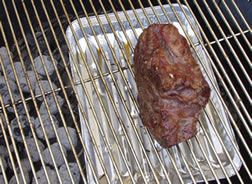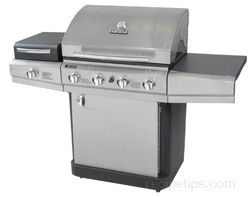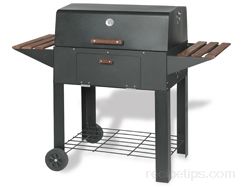|
Knowing the difference between Direct and Indirect styles of grilling and which style complements your main course is the start to a great meal. The grill type can be gas or charcoal, while the style of grilling, Direct or Indirect, should be based on the thickness of the food and required cooking time.
Direct Grilling
 |
Indirect Grilling
 |
| Best technique for foods such as hot dogs, brats, steaks, hamburgers, fish, and pork chops. Any main course that is 2 inches thick or less should be grilled using the Direct grilling method. |
Best technique for foods such as beef roasts, pork roasts, whole turkeys, and whole chickens. Any main course that is greater than 2 inches thick should be grilled using the Indirect grilling method. |
|
Fire is built directly underneath the food to be grilled. The food is cooked by direct heat, placed 3 to 6 inches from heat source.
Coals are layered directly underneath the food and lit. |
Fire is built to the side of where the food is to be grilled. The food is cooked by radiant heat rather than direct heat (as if in an oven).
Coals are lit using only one half of the grill or surrounding outside edge. No hot coals should be directly underneath the food.
When Indirect Grilling with a gas grill, the burner below the area where the food will be placed is turned off after preheating. A drip pan is placed directly under the food. |
| The lid can be left up or down. Typically food is grilled with lid down to ensure even doneness. |
The lid must be left down, acting as an oven door. |
| Food is cooked much quicker than the Indirect grilling technique. |
Food is cooked slower than the Direct grilling technique. |
Pre-heat

Gas Grills need preheating for at least 10 minutes before cooking (internal temperature should reach 500º F). Light the grill and shut lid with grill burner set on high. When Indirect Grilling, the burner below the area where the food will be placed is turned off after preheating. A drip pan is placed directly under the food.

Charcoal Grills also need preheating. Before lighting, open bottom vents of grill. When using Indirect Grilling, coals are typically placed to the opposite half of where the food is to be placed. Another method is banking the coals into a ring around the outer edges of the food.
How much charcoal? Start by spreading 1 layer of charcoal on bottom of grill, extending 1 to 2 inches from where food will be placed. This should be plenty of charcoal for normal grilling. Pyramid this charcoal, add lighter fluid, and start fire (leaving grate off). Charcoal must be red hot and have a thin white coating of ash, typically 20 to 30 minutes. Before grilling, use tongs to spread hot coals into a single layer once again or set up for indirect grilling. Replace grate. Add up to 8 to 10 coals every 30 minutes to add cooking time if needed (generally during Indirect Grilling).
Preheating grills at a high temperature setting helps to seal the juices of your meat when you first place the meat on the pre-heated grill. Decrease temperature or raise grill grate after sealed to insure meat is cooked thoroughly and not merely burned on the outside.
An easy method for estimating the grilling temperature is to place the palm of your hand near the level at which the food will be positioned above the heat source to see how long it can remain before being removed due to heat. If you can leave your hand above the heat source without discomfort for:
|
Approximately 5 to 6 seconds |
Low to Medium Heat |
| Approximately 3 seconds |
Medium to Medium High Heat |
| Approximately 2 seconds |
High Heat (pre-heat) |
FYI …
The term Barbecuing refers to an Indirect Grilling technique for cooking foods slowly for long periods of time using indirect, low-heat generated by smoldering logs or woodchips. The best temperature for barbecuing is between 200º and 300º F. If temperature rises above 300º it is considered Direct Grilling.
Prepare for grilling by spraying the grate with a no-stick cooking spray (or brush on vegetable oil), to assist with clean-up later as well as keep the food from sticking. Do this before starting the grill, when grate is cool.
On a charcoal grill, use a spray bottle filled with water to tame flames that flare up from the food drippings. If flames get out of hand on a gas grill, the safe practice is to shut the gas off until flames are extinguished and then re-light.
Cleaning the grate soon after cooking is the best way to keep it clean. If you have a grate that will fit into your self-cleaning oven you can clean your oven and grill grate at the same time. Typically, a wire brush is used to remove leftover food.
Safety
- Do not add starter fluid to coals that are already hot
- Do not use a grill during heavy winds
- Keep grill in an open area, away from flammables.
- Be within reach of a water hose or have a small fire extinguisher readily available.
| 
